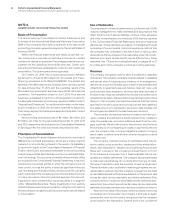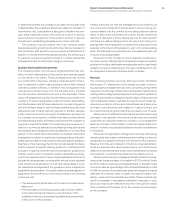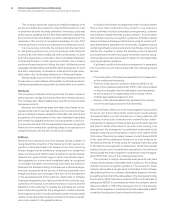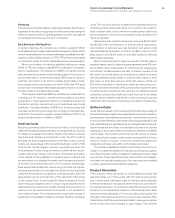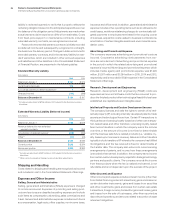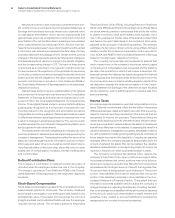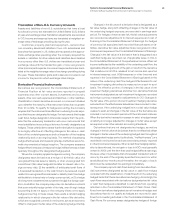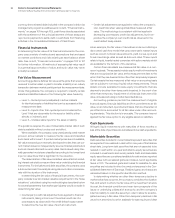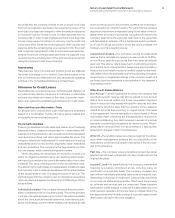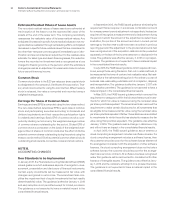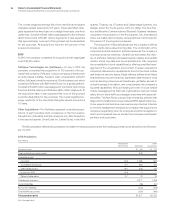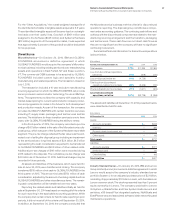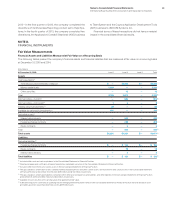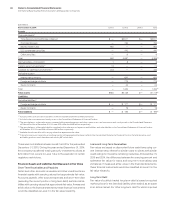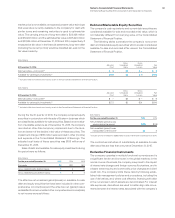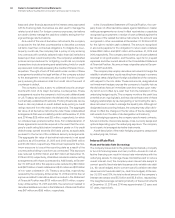IBM 2015 Annual Report Download - page 94
Download and view the complete annual report
Please find page 94 of the 2015 IBM annual report below. You can navigate through the pages in the report by either clicking on the pages listed below, or by using the keyword search tool below to find specific information within the annual report.Notes to Consolidated Financial Statements
International Business Machines Corporation and Subsidiary Companies
92
Estimated Residual Values of Lease Assets
The recorded residual values of lease assets are estimated at
the inception of the lease to be the expected fair value of the
assets at the end of the lease term. The company periodically
reassesses the realizable value of its lease residual values. Any
anticipated increases in specific future residual values are not rec-
ognized before realization through remarketing efforts. Anticipated
decreases in specific future residual values that are considered to
be other-than-temporary are recognized immediately upon iden-
tification and are recorded as an adjustment to the residual value
estimate. For sales-type and direct-financing leases, this reduction
lowers the recorded net investment and is recognized as a loss
charged to financing income in the period in which the estimate is
changed, as well as an adjustment to unearned income to reduce
future-period financing income.
Common Stock
Common stock refers to the $.20 par value per share capital stock
as designated in the company’s Certificate of Incorporation. Trea-
sury stock is accounted for using the cost method. When treasury
stock is reissued, the value is computed and recorded using a
weighted-average basis.
Earnings Per Share of Common Stock
Earnings per share (EPS) is computed using the two-class method.
The two-class method determines EPS for each class of common
stock and participating securities according to dividends and
dividend equivalents and their respective participation rights
in undistributed earnings. Basic EPS of common stock is com-
puted by dividing net income by the weighted-average number
of common shares outstanding for the period. Diluted EPS of
common stock is computed on the basis of the weighted-aver-
age number of shares of common stock plus the effect of dilutive
potential common shares outstanding during the period using the
treasury stock method. Dilutive potential common shares include
outstanding stock awards, convertible notes and stock options.
NOTEB.
ACCOUNTING CHANGES
New Standards to be Implemented
In January 2016, the Financial Accounting Standards Board (FASB)
issued guidance which addresses aspects of recognition, mea-
surement, presentation and disclosure of financial instruments.
Certain equity investments will be measured at fair value with
changes recognized in net income. The amendment also sim-
plifies the impairment test of equity investments that lack readily
determinable fair value. The guidance is effective January1, 2018
and early adoption is not permitted except for limited provisions.
The guidance is not expected to have a material impact in the
consolidated financial results.
In September 2015, the FASB issued guidance eliminating the
requirement that an acquirer in a business combination account
for a measurement-period adjustment retrospectively. Instead, an
acquirer will recognize a measurement-period adjustment during
the period in which the amount of the adjustment is determined.
In addition, the portion of the amount recorded in current-period
earnings by line item that would have been recorded in previous
reporting periods if the adjustment to the provisional amounts had
been recognized as of the acquisition date should be presented
separately on the face of the income statement or disclosed in the
notes. The guidance was effective January1, 2016 on a prospec-
tive basis. The guidance is not expected to have a material impact
in the consolidated financial results.
In July 2015, the FASB issued guidance which requires all inven-
tories, except those using the last-in, first-out or retail methods, to
be measured at the lower of cost and net realizable value. Net real-
izable value is the estimated selling price in the ordinary course of
business, less reasonably predictable cost of completion, disposal,
and transportation. The guidance is effective January1, 2017 with
early adoption permitted. The guidance is not expected to have a
material impact in the consolidated financial results.
In May 2015, the FASB issued guidance which removed the
requirement to categorize within the fair value hierarchy all invest-
ments for which fair value is measured using the net asset value
per share practical expedient. The amendments also removed the
requirement to make certain disclosures for all investments that
are eligible to be measured at fair value using the net asset value
per share practical expedient. Rather, those disclosures are limited
to investments for which the entity has elected to measure the fair
value using that practical expedient. The guidance was effective
January1, 2016. The guidance was a change in disclosure only
and will not have an impact in the consolidated financial results.
In April 2015, the FASB issued guidance about whether a
cloud computing arrangement includes a software license. If a
cloud computing arrangement includes a software license, then
the customer should account for the software license element of
the arrangement consistent with the acquisition of other software
licenses. If a cloud computing arrangement does not include a
software license, the customer should account for the arrange-
ment as a services contract. All software licenses recognized
under this guidance will be accounted for consistent with other
licenses of intangible assets. The guidance was effective Janu-
ary1, 2016 and the company will adopt it on a prospective basis.
The guidance is not expected to have a material impact in the
consolidated financial results.


